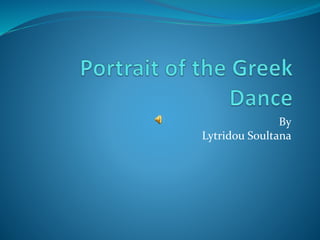
Portrait of the greek dance
- 2. Dance has always played an important role in the life of a Greek. It is an expression of human feelings and everyday life. The Greeks danced at religious festivals, ceremonies; they danced to ensure fertility; to prepare for war and to celebrate victories; they danced at weddings; to overcome depression and to cure physical illness. Almost every dance has a story to tell. Dance was regarded as one of the highest forms of art. INTRODUCTION “ The dance, of all the arts, is the one that most influences the soul. Dancing is divine in its nature and is the gift of the gods.” Plato
- 3. The Pyrrhic, or weapon dance (a form of mock combat) taken from Crete and perfected in Sparta, was the ideal. Plato and his mentor Socrates said that every educated man should know how to dance gracefully by which he meant the manly exercises that kept the body strong and ready to do its duty on the battlefield
- 5. Traditional dance continues to be passed from generation to generation, which in turns maintains national identity. Folklore is the term used for traditional dance when performed out of its traditional social context. The principal characteristic of folklore dance is that it is not transmitted in a traditional manner but by a process involving dance teachers and gym instructors.
- 8. Greece has 6 mainland regions: Epirus, Macedonia, Thrace, Thessaly, Cent ral Greece and Peloponnesus. REGIONAL CHRACTERISTICS
- 9. The Greek islands fall into the following categories. The Ionian islands between Greece and Italy the Saronic islands near Athens, Cyclades occupying the central Aegean Sea, the North Aegean islands close to the West coast of Turkey, the Dodecanese islands, occupying the southeast of the Aegean, between Crete and Turkey, the Sporades which are a small cluster of islands near the island of Euboea, and Crete, the largest island which lies in the southern part of the Aegean Sea. Although Cyprus is an independent country, it is however the largest island inhabited by Greeks and falls within the Greek major cultural regions. THE GREEK ISLANDS
- 10. Asia Minor which is separated from Europe by the Bosporus, the Sea of Marmara (Propondis) and the Aegean Sea was previously inhabited by Greeks since ancient times but the majority have found refuge in Greece following the Asia Minor Disaster and the burning of Smyrni in 1922, Generally, Asia Minor dances are divided into four groups; Pontus, Cappadocia, the Coastal Regions and the urban centres of Constantinople and Smyrna. ASIA MINOR
- 13. Ο Χορευτικός Όμιλος Θεσσαλονίκης ιδρύθηκε το Δεκέμβριο του 1990. Στόχος του είναι η έρευνα του ελληνικού παραδοσιακού πολιτισμού, η διατήρηση και διάδοση της ελληνικής παράδοσης μέσω των χορών και των τραγουδιών της κάθε περιοχής της Ελλάδας. Έδρα του Χ.Ο.Θ. είναι η Καλαμαριά
- 14. CAPPADOCIA MACEDONIA «Όταν χορεύεις γράφεις στη γη αυτά που θέλει να πει η ψυχή σου. » Κ.Καβάφης